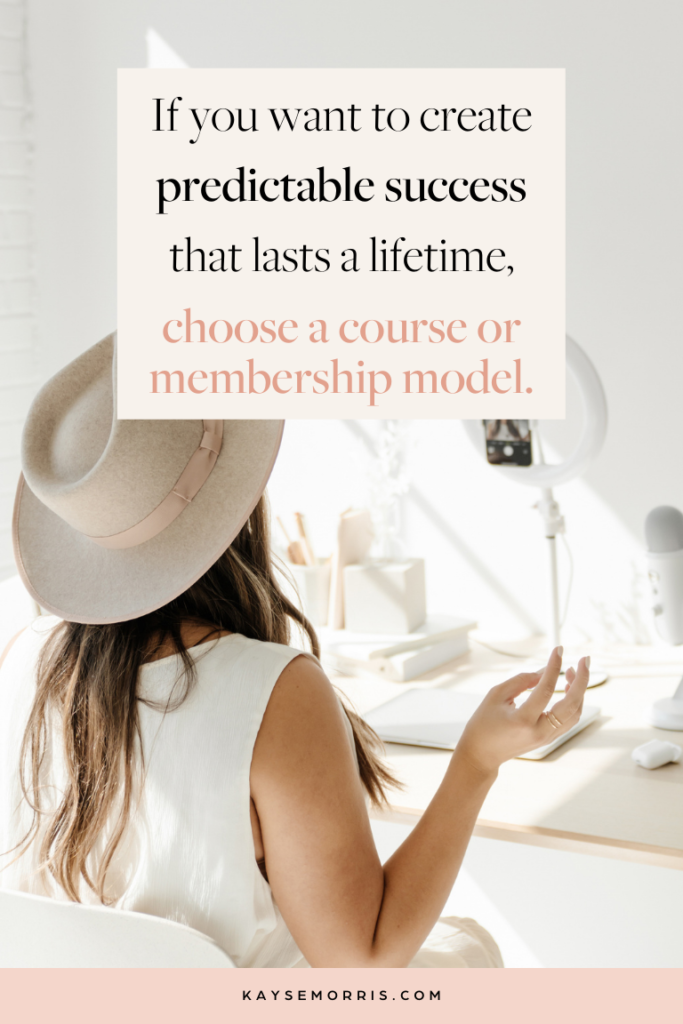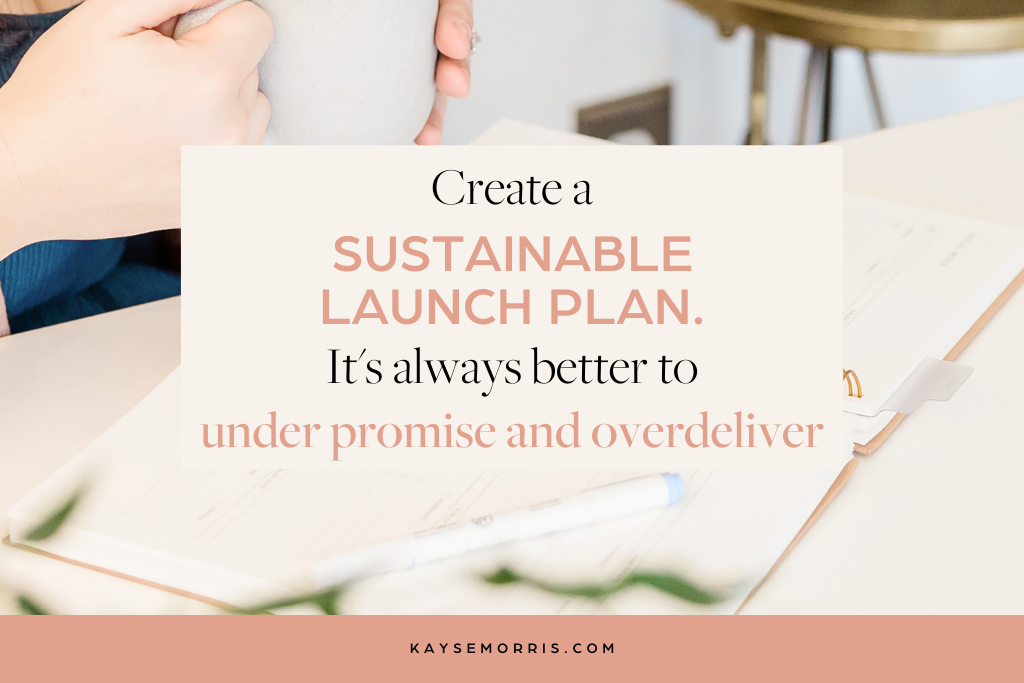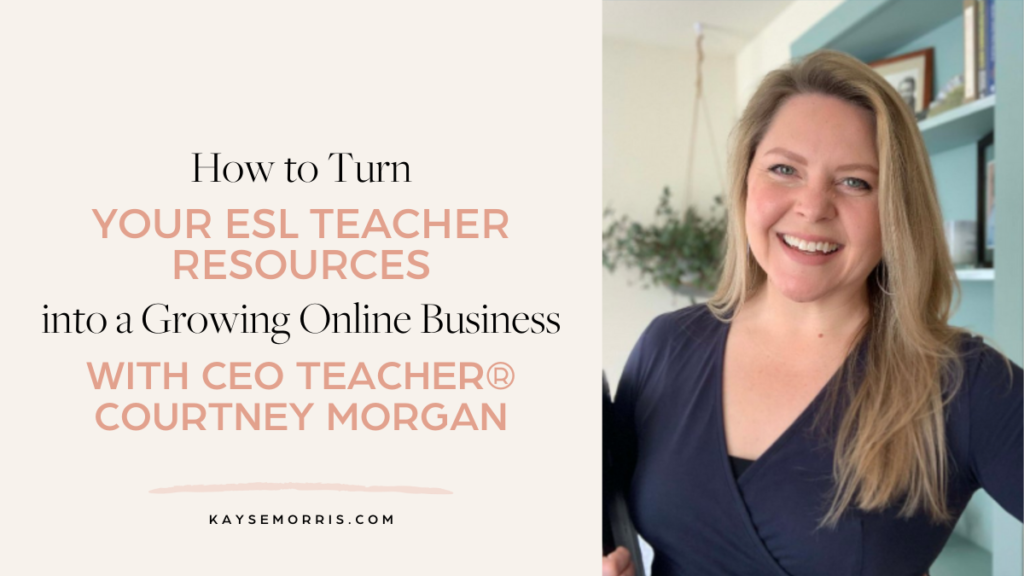How to Turn Your ESL Teaching Resources into a Growing Online Business with CEO Teacher® Courtney Morgan
Today we get to chat all about ESL teaching resources with an amazing CEO Teacher® trailblazer, Courtney Morgan. What is so special about this post is that you're going to get a little behind-the-scenes look at what our coaching looks like inside of our CEO Teacher® programs. Courtney actually won the opportunity to have a recorded 1:1 coaching call with me. What is different this week, is that she got to ask all the questions and you will benefit from her questions as well as the answers from this special episode.
Courtney runs The All Access Classroom where she has developed a heart for enabling English language learners, or multilingual learners, to have access to grade-level content that mirrors their classroom experience. Her business is all about the different avenues aimed toward building equity and valuing every single diverse learner that we have in our classrooms and making sure that they're supported well.
Courtney was a second, third, and fourth-grade teacher for many years. She received her Master's in Multicultural Education at the start of her career in Virginia. It was an amazing Petri dish of learning for her at the beginning of her journey. She had the opportunity to pursue being an ESL teacher, but she loved being a classroom teacher and the right doors just didn't open at that time. So she decided to stay in the classroom because she loved it so much. Over the course of 15 years, she ended up moving to North Carolina where she currently resides.
Eventually, she started feeling a tug to become an ESL teacher and really fully pursue that option. Something that she had experienced in the classroom was a sense of overwhelm knowing that she had multilingual learners in her class who needed significant, specific support. Even as a national board certified teacher who was confident in so many areas of her own teaching practice, she still felt a sense of guilt. A sense of needing to be doing more for those students. Yet she didn't feel like she had the tools or the training or the support to do it well.
How Creating ESL Teacher Resources Changed The Trajectory of Courtney’s Life
When she transitioned into her current ESL role, that became a top priority. How could she support her fellow educators, specifically Gen Ed teachers who had all the motivation to serve those learners, but didn’t have the tools to do it? So in 2020, Courtney joined the CEO Teacher® Program thinking it sounded kind of fun. She had never made a TPT resource ever. She had bought things on TPT, but she thought creating resources on TPT was a fun side hobby. Then she started feeling more serious about the business side of things and began market research, and trying to listen to colleagues. Getting a sense of what was happening in different schools, different districts, and different states regarding supporting English learners. She realized that there are a lot of teachers that need additional support, including ESL teachers, ELL specialists, and Gen Ed teachers.
Courtney started feeling like she wanted to design a course. And fortunately, there is a lot of support in the CEO Teacher® level 2 program all about creating courses. So she had all the support she needed to get started with her dreams. She got brave and did it dirty and scared. She realized that if she didn’t put her ideas out there to see if people want it she would never know what it could become. The amount of response that she has been getting from people emailing, questions in her DM’s, districts asking if it’s something they could do for staff at their school. It has been a WILD ride.
Courtney is continuing to get a feel for what the needs really look like out there for ESL teachers. Is her course something that schools would want? Is it something that ELL teachers are needing? Now that she has had quite a few ELL teachers join the course, she is spending 2022 learning how to market it better to Gen Ed teachers. A lot of times the additional support is off their radar unless it has been specifically offered through their school.
Courtney’s success has been amazing, but it's not that no one else has experienced this. We have a lot of CEO Teacher® trailblazers that have gone through this exact same path. I love that Courtney just literally started. If you're looking at a timeline of events from when she started as a teacher entrepreneur (2020) until now, you have to realize she hasn’t been at this for 10 years. To know that she just started and just went for it in every way has been absolutely remarkable.
Turning Your ESL Teacher Resources into a Growing Online Business
That leads us to Courtney’s first question: What should she do now? She wanted a little bit of direction: should she make products that cater to her people to help them in their classrooms? Or should she go all in with this course thing? Really her business could go in many directions. She could focus on ELL teachers or ESL teachers, or districts as a whole. I encouraged her to think of the big picture.
Courtney said it's a tricky spot right now. When she first started, she developed this great grand vision for these units that she was going to develop. When she began she was asking the question of what she needed as tools and resources for the newcomer English learners in her classroom. She originally wanted to create something that was going to teach content, that was accessible and had some sort of translation or visual support. So she started creating units that would have been the unicorn of resources. As she created that first bundle she realized it was a lot. She was putting audio translation and creating differentiated levels for every lesson. Courtney reminisces about the intensity of developing the unit. When she was finished she was really proud of it. And knew it was something that could be really helpful to a lot of teachers. She still believes that, but also reflects on how incredibly time-consuming it was to create it.
On the flip side, she also has her first launch of a course under her belt. She is about to launch again and is really excited to continue to develop and hone in on the course materials, and start building a community around the course, and really flesh it out. She knows that idea continues to require work and effort. It's a lot when you're building up to a launch and you're creating email sequences and visuals and materials and all the things. Eventually, she would like to turn the course model into an evergreen program.
So she is looking at these two different paths that are both helpful for ELL teachers. Where she struggles is with her own time management. Not in the sense that she doesn’t know how to manage her time. But instead, she has a very limited amount of time as a full-time teacher. I love her question because I think that at any point in a teacher entrepreneur's journey, they are going to be faced with this question. Do I stay on the path of TPT resources or do I branch out? And what if I'm more passionate about one and than the other. I think the answer is twofold here. And I think it goes back to where you genuinely feel like this road is going to take you. And I think the answer can be different for everyone.
When we think about the path of a CEO Teacher®, especially with the trailblazer attitude, we have a specific step-by-step path. One that we feel has sustainability and predictability. For us inside of the CEO Teacher® program, we like to start with a Teachers Pay Teachers storefront because it's an easy way to make passive revenue. As Courtney said, it's a lot when you do it the right way, and put in the quality that the teachers deserve. But the great thing about TPT is that you can make money every single day after you have done the hard work in the beginning. I haven't put up a new resource on TPT in nearly three years and I'm still generating income, which is remarkable. The downfall with TPT is that you are very limited on the access that you have to those teachers who purchase from you. Meaning you don't have their email addresses. You can't get in their classrooms with them. You can't share even more stuff with them to let them know how your business is going to expand.
That's where Courtney has been smart. She created her course and is now taking them on the journey. But as she said, that takes a lot of effort too. I can't believe Courtney is still in the classroom and contemplating these two options. I remember those days and 40 hours a week plus building a business and a family and it's just hard. So if you're at a crossroads and saying Kayse, this sequential path of putting all the eggs into Teachers Pay Teachers creating passive revenue may sound great in theory, but I really have to make a choice here, so do I go TPT, or do I go the path of the course?
If I'm looking at the predictable success that lasts a lifetime, I'm going to always move you into what we call the level two option. Which is the course or membership or program model, because you have a business that actually belongs to you. And that's powerful. After years and years of being on calls with online marketers where I would explain to them the phenomenon of TPT and how much money I was making. They gave me all these marketing strategies about funnels and emails. And I was like, wait a minute. I don't, I don't have my customers like email lists. And they said, well, what about their names and their email addresses? I was like, oh wait, I don't have their names either. And I don't know their demographics, I don't know how old they are and I don't know where they live. And they were like, you're crazy. And I remember being really offended by that.
I was making bank, and I felt like they just didn’t understand. Every one of them said you've got to own your own business. So a very long-winded explanation here. If you were going to take the slow path, I would go TPT all the way into level two of selling your course. If you need a fast track, I would go all-in on the course because I see this being so valuable. Courtney also said “I've got all these other courses in mind”, and that is the perfect brain of an entrepreneur. Multi-passionate with 1,000,000 branches of where the ideas could go. But if I could give any advice, looking back on the last 10 years of our CEO Teacher® journey, is that the more simple you can make it, the more successful you can be.
I am still learning this because we have our whole 2022 vision out on paper. Everything is planned. And over the break, my husband said he thinks I should cut out a really big thing that I want to do in 2022. And I was like, Oh, Heck No. And he was like, you're over-complicating it. And you know, it's interesting to think that he might be right. Now as a team we're just chatting about how we can simplify those ideas because it just makes everything in life so much easier. So if you are like me and Courtney and you're thinking of all these great ideas, I want to encourage you to ask, how can I take these ideas and encompass them into one great, beautiful masterpiece rather than a million different paintings?

Courtney doesn’t want to let go of the idea of creating resources completely. That could become a recurring income opportunity for her. Setting the expectation for herself, one that's realistic and not adding pressure while she is working full time. One of her goals for this year is to really streamline her own daily schedule and systems, use her time wisely and take care of herself a little bit better.
What's really cool about the future of education is that it’s forever. We've known of these huge companies that are pushing into school systems and selling their books and their programs. And what's really cool is that now we're seeing the evolution of the educator being able to step inside of the classroom or inside of the school systems and districts. To sell programs that are actually much better for the students because they get it, they're not at this big corporate level. I really want you to dream big when you plan your business goals.
Courtney has also been adding social media to her business plan. And her next question was about ESL resources and social media platforms.
She has been going live weekly on Instagram doing a ‘Tuesday Try It'. A really quick, easy mini PD all about ESL teaching resources, and she’s come to enjoy them and definitely wants to continue doing them. She knows that Facebook continues to be king. And she wondered if she should consider doing lives there as well to build her Facebook page. She doesn't want to take on too much. So she asked if it makes sense to repurpose the content from her weekly IG lives into Facebook lives? Or would that be redundant?
I love this question because I think that as the creator, we feel that way. Like, oh, I've already said this, or, people are going to get tired of hearing from me on this subject. The average number of people that see your posts on any given platform is significantly low. Around 3% – 5% of your people see what you post. So the likelihood of them seeing what you post on both platforms is even smaller. So I say yes, to repurposing content 110%. We are following this strategy to the nth degree in 2022.
And one way that we are doing it is so we are going to have our weekly podcast, which is what we call the core content. Inside of the CEO Teacher® programs we share our strategy using our CEO Teacher® Pyramid, where our podcast core content is at the top. And then we take that and we repurpose it for all of our other things. So we're going to be going live on Facebook, sharing our strategies in a little bit more tactical way or a little more visual way. Teaching some strategies with visuals is a little bit easier than just listening to them. Same exact thing though. And then we'll also share that on Instagram and our FB posts too. I'm always going to push you to Facebook. What Facebook does is reward you in ways that Instagram never can, although IG is Facebook's child. And I think that what is so important is that people forget how powerful FB is. Or they think my people aren't really on Facebook or Facebook is old and lame. But Facebook is and will always be for the foreseeable future, the great and powerful Oz.

So when we spend our money and our marketing advertising, it all goes back to what Facebook has going on. And there is a new evolution of what the internet is going to look like. I've done a lot of research recently on Meta and what that means. Basically, there have been 3 different levels of the internet over time. We're about to move into the third wave of what the internet is going to look like. Back in the day, we had dial-up with a few message options and some search engines like Yahoo and Bing, and then we moved into what the social platforms are today. The 3rd wave is moving us toward and into a virtual world.
This is what prompted me to do a lot of research because I found that FB is very interested in creating a real-world experience for its users with everyday virtual experiences. So if you could potentially teach a lesson to teachers exactly, as you would, as if you were in person with them as a presentation, you're going to be rewarded. More than people that are just setting up their phones and going live real quick. So it's really interesting to think about what teaching can become in this new world, what teaching already is. And I think that we've found that through virtual learning, but things are changing and we know that.
Getting back to Courtney’s question, I encourage everyone to actually stream to both FB and IG at the same time. It's not super easy for me, because I kind of get lost in the comments of both. But you could also just schedule them for a specific, consistent day and time and then 30 minutes later on the second platform. And the great thing about Facebook lives is that you can repurpose those for search engine optimization and so much more. We also found a lot of success with Facebook premiers. Which means you don't have to go live. They can be pre-recorded videos. So if you find time to record during the week, and then you upload them to Facebook as a premier they appear live to the people watching them. So instead of saying live and flashing, it says premiere, but our best watched Facebook live was a premiere.
Courtney’s next question was about naming ELL resources
The resources that she has envisioned all go together in a coherent set with some overlapping components.
- A vocabulary element
- An interactive choice board element
- An assessment element
These elements are consistent across each content unit that she creates. She wondered if having a consistent naming structure for the sake and benefit of her customers to identify familiar content should override any other SEO considerations. This was a great question that we've never really covered in depth. And I think that it's a really important thing to consider. Her current resources have SEO-friendly titles. She definitely considered SEO as far as the subject area, and the content but she also used some consistent terms with whether it was a vocabulary element or an assessment element. My advice would vary depending on where people are on their CEO Teacher® journey.
A lot of students come to us and they have a great name for a product that's brand new that they've just created. I think about one of my dear friends, she has something called TABLETS and she has trademarked that term and she is known for that product now. If you type in Tablets on TPT, you're going to see her stuff. And it's amazing, but I wouldn't give that advice to someone just starting out. She was already very well established. And when she came up with this product, people were already loving everything that she did. So they would rush to buy her tablets.
But if you're brand new and you're coming up with things that no one is searching for, it's going to be really hard for people to find it. Could you potentially change it to a universal name you came up with later? Yes. So here's my recommendation for anyone just getting started with creating resources, I would optimize your key term. I would also use that universally on a lot of different products just to make sure that people understood what they were getting. If you were going to name it, the exact same thing over and over and over and over and over again, I would say absolutely not.
So here's an example of this. Our editable sight word games do really well. We have January editable sight word games, February editable sight word games, June editable sight word games, etc. We're utilizing the same long-tail keyword, ‘editable sight word games', but we're adding on that little indicator of this is for January, February, June, etc. Then kind of spice up the description. Don't start sentences the same, try to make them unique. That tells the search engine we're not really producing duplicate content.
Moving into creating ESL Teaching Resources for Teachers
Courtney has an opt-in for her ESL Teacher Resources course that has been active for nine months or so. And it's been very effective. She wondered if there was a recommended length of time to keep an effective opt-in active before either replacing it with a new one, refreshing it, or adding a second one.
My answer: if it ain't broke, don't fix it.
Originally our optin was 10 Steps To Get Started Selling Your Teaching Resources Online. We changed the title to Start or Expand Your Online Teacher Business. We made it cuter and took the steps out, and gave it a new title. And in 2022 we're actually combining some of our more beneficial smaller optins together to be one big beautiful masterpiece.

If you want to change something and it's currently working, change up how cute it is or give it a more on-brand look. But if it's working and the title is working, don't try to fix it. My original thought for making the change was that if people have already downloaded the 10 steps workbook, I wanted them to know that we have other things that they can use. But that's going at it from the wrong perspective. You should always be thinking of your newest customer. And when someone's just coming into your world, what's going to grab their attention first. For us, it makes so much sense that people wanted the 10 steps to get started. They didn't want to ‘start or expand’, which didn't resonate with them. What I've learned more than anything though, is to keep it simple. And you have to remind yourself every single hour in the world that we live in because the shiny object syndrome is so real. The most successful people that I know have done the same thing over and over and over again. And for me, that gets really boring and I don't like it, so I want to change it. I'm trying to fall in love with the process rather than trying to change the product. I want to encourage you to do that as well. Fall in love with the process of your beautiful opt-in and how you're going to share it with the world and don't change the end product if it's doing really well.
Keep your mind focused on the people that don't know you yet, that hasn't been introduced to what you are offering, because that's the gateway that makes the most sense for them. The people that are already on your list are so important for a specific reason, a different reason than your new customers. You have to create new customers to have a thriving business. But it should be a 50/50 split. You want to love on your new customers and get as many new customers as you can while still maintaining the love and relationship with the people that matter most. Because they are the people that are committed to you. Ask yourself, “how am I nurturing and guiding people from the time that they are first introduced to me, to becoming members of my course?”
I was recently scrolling on Facebook and got hit with an ad that was talking about how nurturing customers is dead. In 2022 it said you shouldn't nurture, you should just sell. And I was like, is this really the advice that we're getting? Nurturing is still so important, especially for our customers. If you're an educator or you have some sort of connection to teachers, teachers need holding and loving on and just as their students do. So don't forget who you're speaking to.
Courtney uses the open/close cart model to share her ESL teaching resources through her course. Which I love because it's much easier to nurture your list this way.
It's not like you have to say buy my thing because the thing may not even be for sale. You can just introduce it in your nurture emails. As you're creating your welcome sequence, I want you to create a paragraph that you can place in multiple emails, probably two or three that leads into your program. So for example, tying in a story with your welcome sequence that leads into your program and the waitlist is super powerful. Courtney could tell a story about one of her breakthrough moments when she decided to become an ESL teacher. Or if she had a specific student that had an aha moment, and that's what led her to create the program. Then lead your customers to the paragraph of we're not currently open for enrollment, but if this is something you might be interested in, join our waitlist. And when we do open, I'll be sure to send you VIP access to get into the program. You put the ball back in their court with this style of email. You're not pushy. You're just trying to share that you have something without feeling like you're trying to sell it. And then when you decide to open the cart, you’ll want to go back in and revise that paragraph. Change that paragraph to say, now the program is open if you want to join.
We are toying with the idea of what they call pre-qualified leads. Statistics say that if someone spends money with you, they are 80% more likely to spend money with you again, especially if they like you and they love you. So could you create a very small offer that you could share in your welcome sequence? That is a pre-qualifier for your course, meaning that is something you don't take from your course. But a new small thing. You don't want somebody to feel like, I bought this and then I bought the course, and this is in the course. Perhaps a product that's not on TPT, but that belongs to you. That could allow them to go ahead and get on that VIP waitlist. But being able to get someone to spend with you means that when your cart opens, they're a lot more likely to buy from you. Kind of like a warmup, and it's building trust. It's getting people and experience with you as a teacher, as a coach, and helping them to consider how they could benefit from other things that you're offering. So maybe like a, like a paid workshop, that's just always available to people.
I always think about Amy Porterfield, you know, the GOAT. She has a systems scale as one of her evergreens. And then she also has List Builder Society, which allows people to streamline their business and grab some systems, but also build their email lists. Those two things are vital to creating a digital course. So if you buy either of those smaller offers anytime during the year and you start planning, once she opens the doors to Digital Course Academy, you’ll want into the larger product that teaches you everything. I buy courses by, I feel like the hundreds at this point, just to follow strategy, because it's really interesting to me from a marketing perspective. And that is a huge thing that people are doing right now, and it's called pre-qualifying leads.
Courtney had more great questions wondering about how often to offer her course for ESL teaching resources throughout the year. She has been trying to decide right now for this coming year, does she want two launches or three or is that too many to even consider? She feels like in the summer teachers are more available. But in the fall, not in August, September, but after the dust has settled a bit with the back to school season and teachers are like, whoa, I've got English learners in my class. What do I do now? She feels like October-ish, particularly for schools that might want to purchase the course for an entire cohort or a staff commitment would be a good choice. Then again in February with the winter break season, and then possibly July.
And I say to you, and to Courtney, if you're excited, yes, do three launches, but from experience, launch burnout is a real thing. And so it's this rollercoaster of emotion. I live for doing crazy cool things in our business, and I am not fulfilled if we're not constantly doing new things. But what I've also found is that there's a fine line between getting really excited and doing all these launches and finding happiness and balance in life. So I have to make a decision. Do I want to do three launches? Yes. Will that benefit my family? No.

A good question, as you are planning out your year, is what do you want?
Do you want it to generate a lot of income? If so, grind it out and do it and make a whole lot of cash. That's really cool, but at the same time, what's really really cool? Not being burned out and being happy and not worried so much about the cash flow. Just knowing that it's going to come as your business grows. I used to say, I don't believe there's a wrong time to launch a program to teachers, but I have decided otherwise. We followed all of the numbers. And we now know that we'll never launch a program in August and September because teachers are back to school. Even our podcast downloads, over the last three years in August and September are completely down at the very bottom of our downloads. Why? Because teachers are busy! In the south, we go back in August, but everyone else goes back in September. So unless you have a specific program that is geared toward helping teachers get hired, or set up their classroom space, or get started as a brand new teacher filling out all the things, don’t launch during the back-to-school season.
Courtney reflected on how the CEO Teacher® program has taught her to consider all avenues. Modeled trial and error to try different things and see what works. Watch the data and be creative. We know that some things work, and some things don't and we tweak as we go. So it may be that you just need to experiment with it over time.
Courtney’s next question was about creating a community around ESL teacher resources.
She decided during her first launch to have a Facebook group exclusive community just for those members inside the course. And although she wasn’t seeing as much engagement as she had hoped she thinks as it grows and she gets more people, that's going to increase as well. So it's just a place where she can share announcements and information about her live Q&A times. Encourage connection and questions, contributing to each other's challenges, that sort of thing.
Courtney wondered if she should start a brand new community with her new launch, or start trying to increase engagement with the one she already has. She doesn’t want to lose the people that are invested in the community. She wants them to stay supported and have her as a resource, as a coach to ask questions. My suggestion: Remember to keep it simple. So keep just one community. And as she adds people, the members that were not active will become active again, it's like this it's like fresh blood comes in and people are like, oh yeah, I want to come in and chat.
But I want you to really think about the customer journey and where you want your business to go because you don't have a true business if you have a one-and-done thing. You want people to buy from you again and again. So you have to think about the evolution of your customer? And those people who have bought previously are 80% more likely to buy from you again.
Let me share a crazy statistic with you. 95% of our Level 1 students are engaged in our community by posting in our Facebook group, and liking or commenting on peer posts, which is exciting. We've worked really hard for that over the years, which means that when we do share an announcement, they see it, which is important. So I just want you to think about the customer journey and the community because people come for the content, but they stay for the community, once the content from the course has been consumed. I think about Kristie DeRoche and Kayla Topper and how they finally got to meet in real life. They were students of the CEO Teacher® program three years ago and they've been really close friends ever since. It is really cool that they've made this connection through the CEO Teacher® community.
I want to encourage anyone thinking of starting a community to think about that statistic because teachers need a community and we don't have a lot of positive places online that we can go to. To create a plan to nurture them through the years and allow them to buy from you again and again so that your business begins to flourish instead of you always having to find new customers for your business to run.
And it’s OK to love on them for years before you ask for them to buy from you again.
And to leave you with some Mama Kayse advice: If I've learned anything, it is that even if you're not making as much money as you think you could be making, do what's right, and what's fair. Go ahead and give them a discount (or grandfather them into all the content, because they were the ones that loved you first.)
Whether you create ESL teaching resources or content to help teachers get organized, if you are still looking to decide between course creation and continued resource creation you can read more perspectives here…
Leave a Reply Cancel reply
This site uses Akismet to reduce spam. Learn how your comment data is processed.
Behind-the-Scenes Secrets to TPT Success
This training will not only show you how to make the perfect TPT resource...
l'll also teach you how to make sure it ranks #1 in search (because getting found is how you get paid!) and the secret to rocking your resource marketing!
Seats are limited; sign up now!
3 Steps to Sell Your Resources Like Hotcakes on TPT and Beyond…
save me a spot!
FREE WEBINAR
In this training, I'll show you how to build an online membership in 90 days, so you can have consistent income (in addition to your teaching salary) all year long!





[…] Create a Coaching Program […]
[…] Courtney Morgan was a second, third and fourth-grade teacher for 15 years and then moved into teaching English Learners. Her focus is to support teachers who are serving English learners and help them know how to make grade-level content accessible to them. She would say that she probably identifies the most with Kesha the Course Creator, which was an unexpected turn in her business. […]
[…] Did you know you can get coached by me for free?! I don’t offer one-on-one coaching anymore, but I do coach our podcast listeners each week at the end of our show. We call these “CEO Teachers® in […]